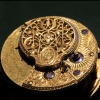-
Recently Browsing
- No registered users viewing this page.
-
Topics
-
Posts
-
By Neverenoughwatches · Posted
You're right Rich, throwing money at something that is practically worthless. I've had i happen a few times, its disappointing, but a lesson learned in checking everything out before you put in too much effort. I'm still tempted to look through a load of balances and wheels i have to see whats doable with the genuine staffs, I'm thinking the wheel that it came with is not genuine, it's had it weight completely hacked down. -
By Neverenoughwatches · Posted
Ok thanks it was just the brass cover next to the previous 3 keyless parts. Normally i wouldn't have expected that to be used to identify, but I've searched American, German and French part catalogs and coming up with nothing for the set lever,set spring and yoke. I will have another look later today. There is another way but you would have to measure the stem very accurately. -
The diameter of the dial side is 40mm, and the other side 36,5mm. Here is another picture
-
By Neverenoughwatches · Posted
The chronometer on the dial might just be a brand name, looking back yes i was mislead by the mention of Remontoir inside the case. Still not sure why it says Ancre Remontoir which translates to anchor winder, i imagine that means lever winder which still suggests to me 2 winding springs. I'm sure i have that same watch with chronometer on the dial ,I've never ventured inside it. My missus looks after 90% of my watches , so i will get hold of that one and have a look inside. Haha no not a remontoire, looks very basic. Good to see the keyless works, can you measure the plate size to cut down on the search for them. Can you lay out that brass bridge cover as well please next to the other 3 pieces. -
That's true. It is not a chronometer. As a matter of fact, I got it with another timepiece which is e real one, and only that (not a watch). I add a few pictures of my Chronometer / watch. no indication of a brand ...
-






Recommended Posts